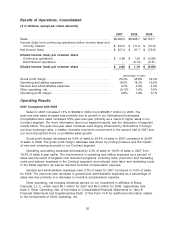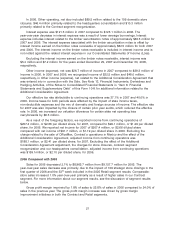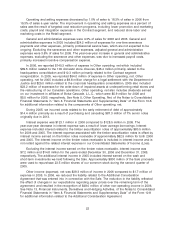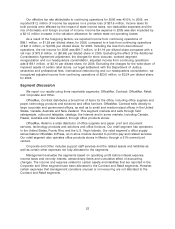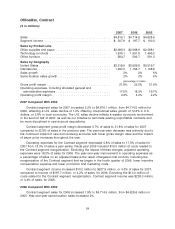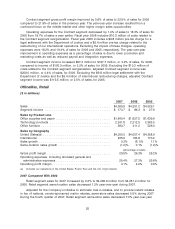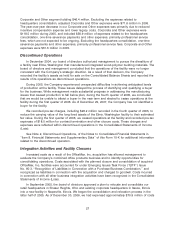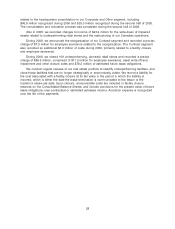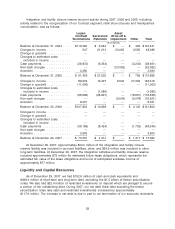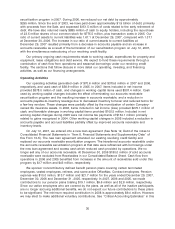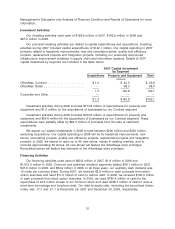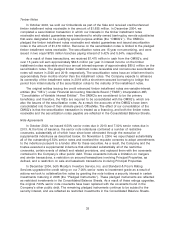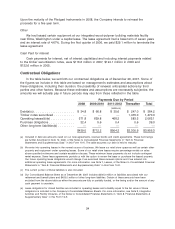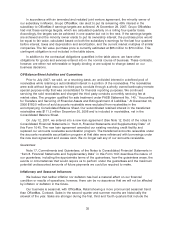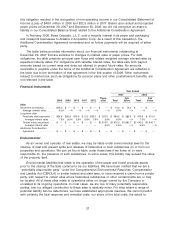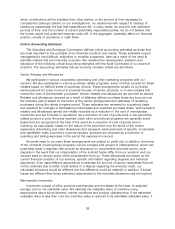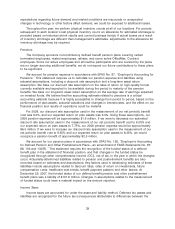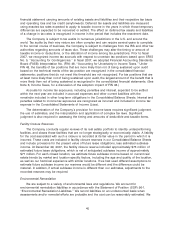OfficeMax 2007 Annual Report Download - page 34
Download and view the complete annual report
Please find page 34 of the 2007 OfficeMax annual report below. You can navigate through the pages in the report by either clicking on the pages listed below, or by using the keyword search tool below to find specific information within the annual report.securitization program in 2007. During 2006, we reduced our net debt by approximately
$295 million. Since the end of 2003, we have paid down approximately $1.9 billion of debt, primarily
with proceeds from the Sale, and expensed $151.5 million of costs related to the early retirement of
debt. We have also returned nearly $885 million of cash to equity holders, including the repurchase
of 23.5 million shares of our common stock for $775.5 million, plus transaction costs in 2005. Our
ratio of current assets to current liabilities was 1.61:1 at December 29, 2007, compared with 1.37:1
at December 30, 2006. The increase in our ratio of current assets to current liabilities at
December 29, 2007 resulted primarily from a decrease in accounts payable and an increase in
accounts receivable as a result of the termination of our securitization program on July 12, 2007,
with the simultaneous restructuring of our revolving credit facility.
Our primary ongoing cash requirements relate to working capital, expenditures for property and
equipment, lease obligations and debt service. We expect to fund these requirements through a
combination of cash flow from operations and seasonal borrowings under our revolving credit
facility. The sections that follow discuss in more detail our operating, investing, and financing
activities, as well as our financing arrangements.
Operating Activities
Our operating activities generated cash of $70.6 million and $375.6 million in 2007 and 2006,
respectively, and used cash of $56.9 million in 2005. In 2007, items included in net income
provided $378.0 million of cash, and changes in working capital items used $307.4 million. Cash
used by working capital changes includes the effect of terminating our accounts receivable
securitization program and the resulting increase in accounts receivable, and a reduction in
accounts payable-to-inventory leverage due to decreased inventory turnover and reduced terms for
a few key vendors. These changes were partially offset by the monetization of certain Company-
owned life insurance assets. In 2006, items included in net income (loss) provided $270.1 million of
cash, and favorable changes in working capital items provided $105.5 million. Included in net
working capital changes during 2005 were net income tax payments of $134.1 million primarily
related to gains recognized in 2004. Other working capital changes in 2005 included a reduction in
accounts payable and accrued liabilities partially offset by improved accounts receivable and
inventory levels.
On July 12, 2007, we entered into a new loan agreement (See Note 12, Debt of the notes to
Consolidated Financial Statements in ‘‘Item 8, Financial Statements and Supplementary Data’’ of
this Form 10-K). The new loan agreement amended our existing revolving credit facility and
replaced our accounts receivable securitization program. The transferred accounts receivable under
the accounts receivable securitization program at that date were refinanced with borrowings under
the new loan agreement and excess cash which reduced cash provided by operations. We no
longer sell any of our accounts receivable. At December 30, 2006 $180.0 million of sold accounts
receivable were excluded from Receivables in our Consolidated Balance Sheet. Cash flow from
operations in 2006 and 2005 benefited from increases in the amount of receivables sold under this
program by $17 million and $43 million, respectively.
We sponsor noncontributory defined benefit pension plans covering certain terminated
employees, vested employees, retirees, and some active OfficeMax, Contract employees. Pension
expense was $10.0 million, $13.7 million and $21.7 million for the years ended December 29, 2007,
December 30, 2006 and December 31, 2005, respectively. In 2007, 2006 and 2005, we made
contributions to our pension plans totaling $19.1 million, $9.6 million and $2.8 million, respectively.
Since our active employees who are covered by the plans, as well as all of the inactive participants,
are no longer accruing additional benefits, we do not expect our future contributions to these plans
to be significant. The minimum required contribution in 2008 is approximately $9.4 million. However,
we may elect to make additional voluntary contributions. See ‘‘Critical Accounting Estimates’’ in this
30


